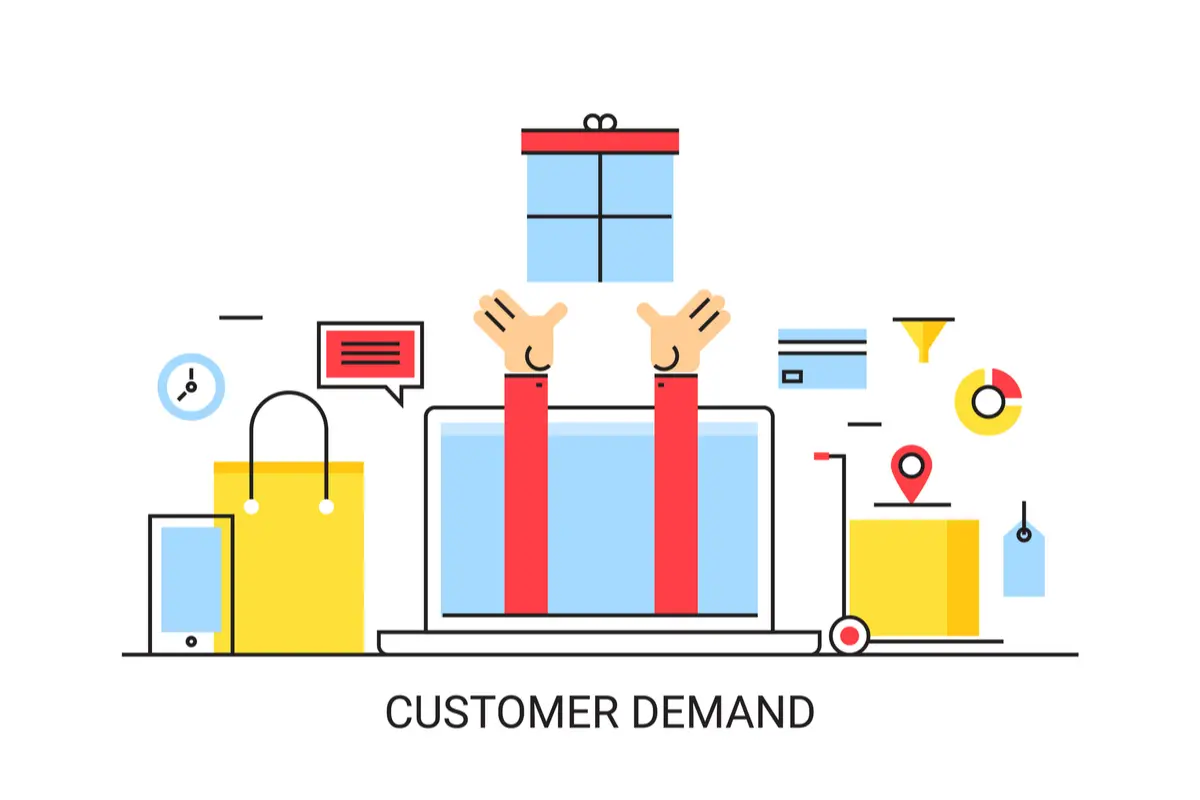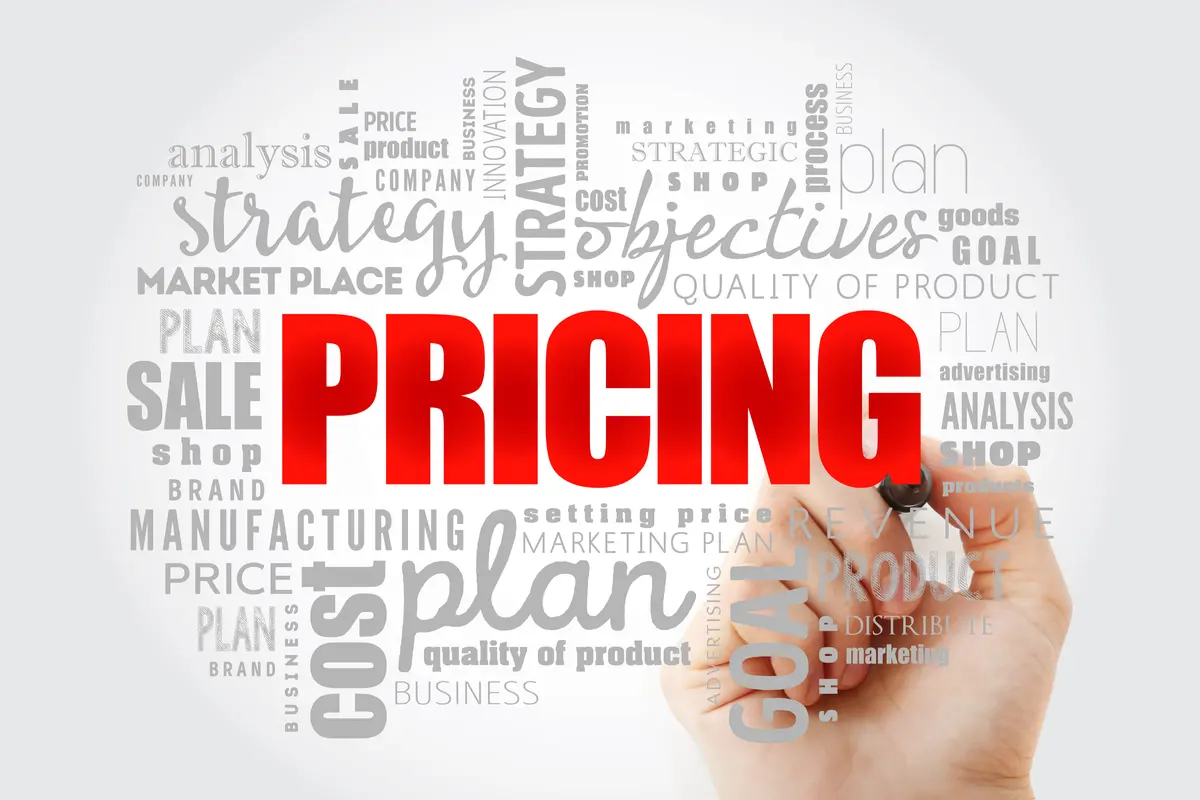Table of Contents
- What is Pricing Policy?
- The Importance of Strategic Pricing
- What to Consider Before Pricing Your Product
- Determine Demand
- Marketing Costs
- Manufacturing Costs
- Consider Distribution Costs
- Market Research
- Research Competitors
- Investigate the Price of Substitutes
- Incorporate Artificial Intelligence
- Decide How Much You Want to Expand Your Market Share
- Determine Your Pricing Policy
- Don’t Go Too High or Too Low
- When to Update Pricing
- More Pricing Policies
- Conclusion
Price is often the determining factor in whether or not a consumer will make a purchase. It is one of the primary measures customers use to compare products and services with those of the competition.
Understanding price can help you make a pricing policy that will attract more consumers and increase profitability.
It’s a bit of a catch-22 because when you are not charging enough, you risk not making a profit, and when your prices are too high, you risk not getting enough customers.
This article will guide you through all the essential steps in pricing your products, so you can find that sweet spot where the price is right.
What is Pricing Policy?

A pricing policy is a systematic approach to pricing various products in the market. A good, strategic pricing policy focuses on these four factors: cost, value, demand, and competition. We will discuss these terms later in the article.
The Importance of Strategic Pricing
Pricing is one of the most important drivers of profitability. Businesses have to price their goods and services strategically to maximize profit. The right price can boost profit faster than any other factor.
Strategic pricing allows businesses to:
- Establish the right balance in demand and supply
- Compete in the market, because it is a tool of competition
- Attract customers and promote sales
What to Consider Before Pricing Your Product

Charging the right price is a critical factor for the success of a business. Companies need to set a price that their target consumers are willing and capable of paying while ensuring adequate income to cover your costs and make a healthy profit.
Before we look at specific pricing policies, let’s take a step back and consider your place in the market. We will discuss the following topics and explore how they can help you to set the right price.
- Demand
- Price Ranges
- Marketing Objectives
Determine Demand

There’s more to pricing than figuring out consumer demand, but not much. This is one of the most important steps to understanding the market and seeing where you fit inside of it. Fortunately, there are tools you can use to determine consumer demand for your product. Below are seven such determinants. Use these to figure out how interested people are in what you are selling.
● Price
It is very likely that if the price of a good is high, the consumer might choose to buy another product or not buy a product at all.
● Taste and Preference
Advertisements play a significant role in impacting our tastes and preferences. The more exposed we are to a specific ad, the bigger the chances of conversion. Consequently, more advertising leads to more demand. It’s important to note current trends also affect taste and preference.
● Consumer Expectation
If a consumer expects a product’s price to change in the future, they will make a purchase accordingly. For example, if a buyer anticipates an item’s cost to increase in the future, they may be more likely to make a purchase. If they expect the price to go down, they may wait to make a purchase.
● Income
The average income of a merchant’s target consumer can affect demand for a product. It’s important to find the sweet spot where the ratio of the customer’s income and the product’s cost is most appealing.
● Price of Related Commodities (Price of Compliments, Price of Substitutes)
There are two types of related commodities: complementary goods and substitute goods. If the pricing of substitute items decreases while your product’s price stays the same, then you may see less demand for your product as consumers choose the less expensive option instead.
● Population
As the population increases, so also may demand.
After considering the above determinants, you will have a better idea about how much demand there will be for your product and how to price it accordingly.
● Calculate the Marketing and Manufacturing Costs
How much you will pay for the product is just as important to your pricing policy as demand.
Marketing Costs
Marketing costs vary by industry, location, target market, competition, and the product that you are selling. Traditional marketing on TV and radio can be passive and expensive. Meanwhile, digital marketing lets you target high intent potential customers through Google Ads and more.
Before marketing any service or product, you should consider the seven P’s of marketing:
- Product
- Price
- Place
- Promotion
- People
- Physical evidence
- Process
To set a marketing budget, you should consider all activities you undertake to market your business, such as advertising expenses and website costs.
You can develop a marketing budget based on a percentage of revenue. It’s recommended to set an annual marketing budget.
If you are a new business making under $150,000 in annual revenue, the ideal budget is 15% to 20% of your overall annual revenue, ranging between $20,000 to $25,000 annually on advertising and marketing.
If your business is well established and is making over $250,000 in annual revenue, and has a marketing team, consider allocating 10% of your yearly income to your marketing cost.
Manufacturing Costs
To produce your product, you need to find a reputable manufacturer that can be a good partner. Finding the proper manufacturer depends on many factors, such as the type of your product and the desired quantity. All these factors determine who you want to partner up with to make a product that you have designed.
Before reaching out to a manufacturer, do your homework and research all the different manufacturing processes suitable for your product, the types of materials you are interested in, etc. Ask every question that you have in mind to your manufacturer to avoid surprises such as their location, volume capabilities, similar product categories, etc.
You can choose to produce your product either domestically or overseas. The advantages of manufacturing in the United States are short lead times, higher quality control, and more reliability. However, manufacturing in the United States can be much costlier compared to producing overseas.
On the other hand, manufacturing overseas, such as in China, may cost you much less money; however, the quality of your product may suffer.
Remember to ask your manufacturer about their payment terms and minimum order quantity.
Consider Distribution Costs

Businesses have to choose the right distribution channel to sell their products. Mainly, there are four distribution channels: direct distribution, distribution through retailers, distribution through wholesalers and retailers, and finally distribution through agents.
- Direct Distribution – Businesses using direct distribution channels do not rely on shops or other intermediaries to sell their products. Direct sales could be made online or through shops owned by the manufacturer.
- Distribution Through Retailers – Large retailers often purchase goods from manufacturers and sell on to consumers. Products reach consumers via one intermediary. This method of distribution Is also referred to as modern distribution.
- Distribution Through Wholesalers and Retailers – This type of distribution channel involves at least two intermediaries: wholesalers and retailers. Wholesalers are businesses that purchase in considerable bulk from producers and then sell smaller batches to many different retailers. This method is also called traditional distribution.
- Distribution Through Agents – Agents can leverage their connections and strong sales skills and communicate with wholesalers and retailers to convince them to sell your product.
Direct distribution channels may come with higher costs. On the other hand, using wholesalers is an effective way for manufacturers to get products stocked in small retail businesses without having the transport costs involved in making small deliveries to each of them.
Keep in mind that each intermediary involved in the chain of distribution seeks to make a profit. The purchase price that retailers and wholesalers pay is inevitably less than the price producers might charge if they were selling directly to the consumer.
Look at Consumer Preferences
Another way to gauge demand is to look at current consumer preferences. It can be hard to figure this out. Factors like culture, education, budget, personal taste, and social pressure can affect which item consumers prefer. Fortunately, market research can help you understand consumer preferences.
Market Research

Marketing research is an organized effort to gather information and better understand target markets or customer needs. It is essential for the success of a business and aims to:
- Measure customer demand
- Identify trends
- Analyze buyer behavior
- Analyze competitor behavior
- Identify target markets
- Determine sales potential
Market research comprises five main steps: defining objectives/problems, designing the research plan, collecting data, analyzing data, developing insights, and finally, applying the knowledge.
Define Objective/Problem
The first step of market research is to define the objectives and the needs of your research. This helps you figure out what you might be doing right or wrong in your business and solve a specific problem.
Your objective is to understand your target consumers and evaluate their tastes and preferences to understand demand.
Design the Research Plan
The second step is to look at the type of data that you are trying to collect and decide the best methods to manage it. There are many ways to collect data to understand consumer demand and preferences, such as interviewing your consumers and sending out surveys.
Collect Data
After deciding how to collect your data, the third step is to go out to the field and start gathering information.
It is best to ask open-ended questions to get as many details as possible, yield more accurate information, and gain actionable insight.
Analyze Data and Develop Insights
Once you have collected data, the fourth step is to analyze it and transform it into information that you can use.
Action Plan and Implementation
After analyzing your data and developing insights, the final step is to implement an action plan. Based on the information you have collected, you can make the right decision when it comes to your business, product, or service.
In summary, market research aims to collect, record, analyze, and interpret data to make the best decision possible when selling goods, services, or ideas. It’s a valuable tool when developing a pricing policy because it can help you better understand demand.
While conducting market research, you may want to consider researching your competitors too.
Research Competitors
It’s not enough to understand what your customers want. Businesses have to perform competitor analysis to determine their direct and indirect competitors’ performance in the market. This will help you understand why your consumers prefer your competitors.
After you research your competitors, you will know more about whether you should match their prices, or try to undercut them.
A competitor analysis framework allows businesses to:
- Make strategic decisions based on price point and consumer preferences
- Track and analyze their competitor’s existing pricing strategy
- Highlight the strengths and the weaknesses of their company and their competitor’s company
- Uncover potential opportunities in the marketplace
- Identify gaps between them and their competitors in terms of consumer demand
When performing a competitor analysis, you should consider four factors: company highlights, market information, product information, and SWOT information.
● Company highlights
The company highlights include the company’s profile, its key competitive advantage, and why this company is successful in the marketplace.
Simply put, it allows you to understand how it meets consumer demand differently than your business.
● Market information
Market information covers the target market, market share, and your competitor’s marketing strategies.
● Product information
Looking at product information means considering what type of products or services your competition is selling and the distribution channels it is using to meet the needs of its consumers.
● SWOT information
SWOT stands for the strengths, weaknesses, opportunities, and threats related to your competitor. Conducting a regular SWOT analysis helps you stay up to date with consumer demand and grow your competitive intelligence.
Compare your products to your competitors’ and analyze if it has more features and higher quality. If that’s the case, price your products at the same level or higher than your competitors’.
If your product has more minor features and is not as good as your competitor’s product, it is nothing but logical to price it lower.
Some financial experts advise that when your product has the same features, usability, and quality as your competitor’s, it is best to price it a little bit lower. This way, consumers would purchase your product because it is more affordable yet offers the same characteristics.
Investigate the Price of Substitutes
A substitute good is a good that a consumer may substitute for another good if the price of the consumer’s regular choice of preference rises too high or the consumer’s preference is unavailable. The substitution will occur if the products are similar enough to meet a consumer’s need and there is positive cross elasticity of demand.
Cross elasticity of demand occurs when the price of one product increases which causes the demand for another product to increase.
That’s why it is always best to stay alert about the price of potential substitutes and adjust your prices accordingly.
Incorporate Artificial Intelligence
Consumers know where to go to get what they are looking for at the best possible price. This puts pressure on retailers. To stay ahead of your competitors, consider incorporating pricing intelligence tools into your business.
Pricing intelligence tools let you monitor your competitors, understand your products’ profitability, and know what’s happening in the market at any given time.
Decide How Much You Want to Expand Your Market Share
Market share is used to get a rough idea of how large a company is compared to its competitors and market. Investors keep a close eye on market share because it shows the relative competitiveness of services and products offered by the company. A company begins to dominate its industry when market share expands.
Pricing can play a part in market share expansion. By undercutting the competition, you can increase your market share faster. A company with a high market share has the advantage of negotiating with distribution channel members and suppliers on better terms.
You can measure your business’s market share by calculating your company’s sales over some time and divide it by the industry’s total sales over the same period.
The formula for determining market share is total company sales / total industry sales * 100.
You can increase your business’s market share through:
- Acquisition
- Innovation
- Decreasing prices
- Reinforcing customer relationship
- Brand awareness
- Improving quality
Determine Your Pricing Policy

Everything we have discussed so far should factor into how you set the price of your product. Below are four popular pricing techniques.
Cost-Based Pricing
Cost-based pricing is popular with companies that develop products on-demand. It sets prices based on the total cost of a product plus a margin or premium to make a reasonable profit.
Formula
To find out your product’s cost-based selling price, apply the following formula:
Cost + Fixed Profit Percentage = Selling Price
Disadvantages
Cost-based pricing has three main disadvantages. It doesn’t take into account demand, competition, and product life cycle. It is also difficult to accurately estimate total costs. Determining a unit’s cost beforehand is difficult too.
Value-Based Pricing
Value-based pricing sets prices based on the consumers’ perceived value, regardless of costs. Unlike cost-based pricing, value-based pricing is in the marketing managers’ hands.
Disadvantages
To determine the price of a product, marketing managers have to research their specific target to analyze how much money they are willing to pay for a product. The research may be inaccurate, as it is subjective, and it may change over time.
Demand-Based Pricing
As its name indicates, demand-based pricing is influenced by demand. Companies charge high fees when the demand is high and low prices when the demand is low.
Disadvantages
The main disadvantage of demand-pricing is that it is difficult to estimate demand accurately.
Competition-Based Pricing
Competition-based pricing sets prices based not only using costs or value but also on your direct competitors’ prices. The objective is to sell additional volume through lower prices.
Disadvantages
Some claim that this type of pricing is the easiest method to price your good; however, it has its downsides. Price cuts lead to an immediate drop in your sales profit. Competitors can also easily match a price cut.
If your business doesn’t have any direct competitors, this pricing method will not work for you.
Don’t Go Too High or Too Low

Setting your prices too high or too low may damage your business depending on your target market. What is the best way to price your products?
Argument for High
If you’re pricing your products based on the value-based pricing method, pricing your goods a bit high may be logical and beneficial to your business, keeping in mind that your target consumers are willing to pay more.
Increasing your prices may lead to sales volume dropping. On the other hand, it can help you get the most money possible.
Argument for Low
If you’re pricing your products based on competition-based pricing, undercutting the competition is an excellent way to penetrate the market. Decreasing your prices may lead to sales volume rise because you will be offering the same or better quality products at more affordable prices.
When to Update Pricing

The market is constantly changing. Companies must update their pricing model accordingly. Here are three instances when it makes sense to update your pricing.
- Your Brand Gets Stronger – When customers trust your brand, they are usually willing to pay more for your product. That means as your brand gets stronger, you may be able to increase your prices.
- The Market Gets Saturated – When the market gets saturated, a business can deal with it by updating its prices. Companies can reduce their prices to compete with competitors and attract more customers.
- Your Production Costs Decrease – Generally, it becomes less expensive to make a product over time. You may choose to decrease your prices as your production costs decrease.
Know the Cost of Your Product
The selling price must cover that cost price and all other expenses such as shipping, services, customer service, and office space, meaning that you have to sell for a higher price than the actual cost because you don’t want to be losing money.
Market Price
Determine the price that your consumers are prepared to pay for their products. Also, determine your target consumer and how they perceive value when looking at price.
Target Price
After determining your target consumer and how they perceive value, the third step would be to determine the target price. The target price considers your desired profit margin.
Final Price
The final step is to determine the final price range, which is the price at which you will sell the product to the consumer. This range is based on the market price and the target price.
More Pricing Policies

We have only scratched the surface on how businesses will set the prices of their products and services. The following pricing policies are popular amongst companies today.
Price Variation Policies
Price variation happens when a company varies the prices of its goods to match the different market needs. This policy has three main variations: variable price policy, non-variable price policy, and single price policy.
Variable Price Policy
In this policy, businesses sell the same product at different prices. This pricing policy works best when a consumer is buying in large sums and has good bargaining power. Some consider this policy to be a flexible promotional tool.
Non-Variable Price Policy
The non-variable prices policy charges the same price to every consumer. Customers don’t have the opportunity to bargain, and everyone is charged the same way. The fee charged only varies from class to class, such as from wholesaler to retailer, but not from one customer to another.
Single Price Policy
Single price policy refers to when businesses charge the same price for the same item from every buyer, regardless of their class, purchase number, etc. People who buy in bulk may find this policy unpleasing and switch to your competition.
Geographical
Geographical pricing involves setting a price point based on the location where the product is to be sold. This means that a company charges different prices to different customers and different markets as per the local taxation laws and local requirements.
Point of Origin
Point of origin pricing policy charges the buyer the freight cost associated with the product. The seller isn’t responsible for paying the transportation fee to get the products to the destination. In other words, the receiver pays the shipping cost.
Freight Absorption
Companies that have adopted the freight absorption price policy absorb their products’ freight fees wholly or partially. Consumers don’t carry any transportation fees.
There are three freight absorption policy types: uniform delivered price policy, zonal price policy, and base point price policy.
Uniform Delivered Price Policy
Companies who adopt the uniform delivered price policy charge the same price from their consumer in addition to freight, regardless of their location.
Zonal Price Policy
This type of geographical pricing uses zones rather than regions to differentiate between the prices offered. This is an excellent strategy to penetrate a market against competitors while increasing overall revenue.
Base Point Price Policy
This policy allows businesses to select a given city as their base point and charge their customers the freight cost or the shipping fee associated with the base point to the buyer’s location regardless of the city from where the company ships the product.
Promotional
Promotional pricing offers a temporarily lower price to encourage early purchase and generate product sales. Discounts can be provided to the vendor or the customer.
Vendor Discounts
A vendor discount is when you offer a deduction of the price to the vendor. This helps build a great relationship between you and the vendor.
Customer Discounts
Customer discounts come in different shapes and sizes. Businesses mark down their products’ prices by offering different client types of discounts such as cash discounts, seasonal discounts, and quantity discounts.
Strong Brand Pricing
Strong brand pricing sets prices based on how a business wants its customers to perceive its image and products. When a company presents its products as high-end and superior, a higher price will demonstrate its luxurious quality. Incorrect prices can damage a company’s brand image and reputation.
Psychological Pricing
Psychological pricing is a marketing strategy based on the theory that specific prices have a psychological impact. There are three techniques in psychological pricing strategy: prestige pricing, odd-even pricing, and bundling pricing.
Prestige Pricing
This strategy prices products at or near the high end of the possible price range to help attract status-conscious consumers who associate higher prices with superior quality. The high cost of a premium product is used to enhance and reinforce a product’s luxury image.
Odd-Even Pricing
Also known as charm pricing, this technique sets the price of a product a few dollars or cents below a round number. This pricing method is based on the belief that specific prices or price ranges are more appealing to buyers and give the impression that an item is cheaper than it is.
Bundling Pricing
Bundling pricing includes combining several products or services into a single comprehensive package for an all-inclusive reduced price. Pursuing a bundle pricing strategy allows the business to increase its profit by giving customer discount.
Conclusion
Setting the right price for your services or goods plays a vital role in the success of your business. It is how you generate revenue. However, there is not a one-size-fits-all pricing strategy that works for everyone and guarantees success. That’s why successful businesses always conduct market research to identify the right pricing strategy in response to market, corporate objectives, and competitor activities.
Table of Contents
- What is Pricing Policy?
- The Importance of Strategic Pricing
- What to Consider Before Pricing Your Product
- Determine Demand
- Marketing Costs
- Manufacturing Costs
- Consider Distribution Costs
- Market Research
- Research Competitors
- Investigate the Price of Substitutes
- Incorporate Artificial Intelligence
- Decide How Much You Want to Expand Your Market Share
- Determine Your Pricing Policy
- Don’t Go Too High or Too Low
- When to Update Pricing
- More Pricing Policies
- Conclusion


